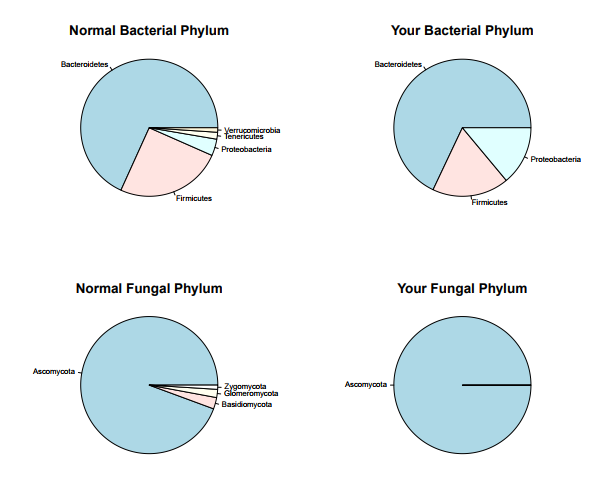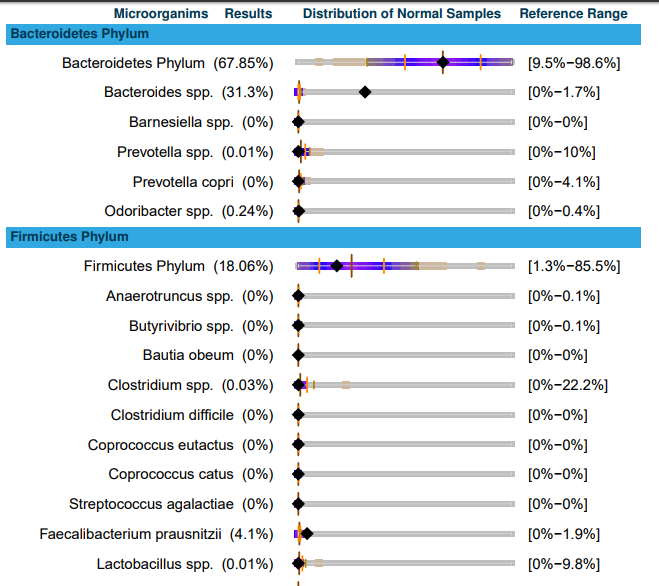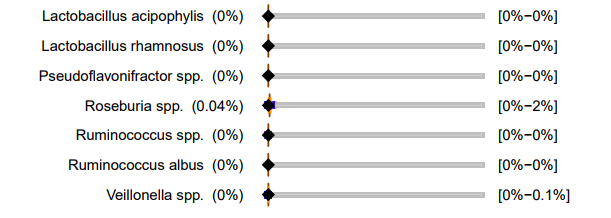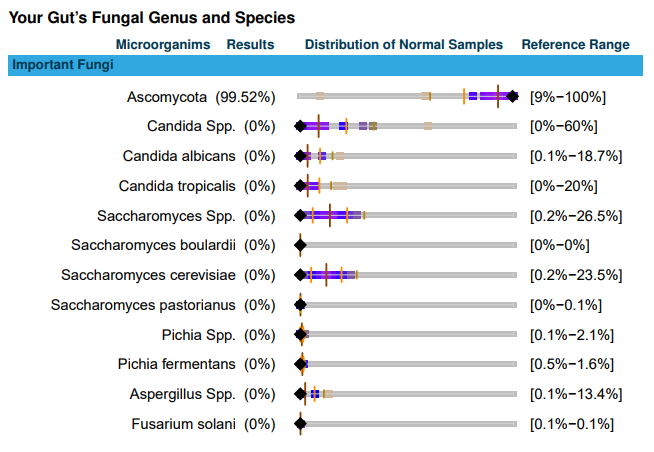A reader forward their results from Biohm (link to kit, $117) with the expected disclaimer:
As a general wellness product, the BIOHM Gut Report & BIOHM Candida Report are for informational purposes only and are NOT intended for use in the diagnosis, cure, mitigation, treatment, or prevention of disease or any other conditions.
Images of Report

While this shows the percentage -- it does not make it clear if there is either overgrowth or undergrowth for either fungal or bacteria. That is -- is the volume abnormally high or low?





Analysis of Report
I like that the mean and +1/1 standard deviation is shown. The unfortunate aspect is that everything is in terms of percentage of all bacteria with the reference rounded to the closest 0.1%. If the normal amount seen is 0.0001% and a person has .04% (400x more) then the chart will show 0% and (0%-0%) -- so no apparent overgrowth... IMHO massive loss of useful information!
To illustrate this, let us look at Lactobacillus. We have 0.01 and the reference range is 0 - 9.8% -- SO IT IS IMPOSSIBLE TO HAVE LOW Lactobacillus according to this report reference range. I would definitely describe this as low lactobacillus. Similarly, Bifidobacterium is 0.02 with reference range of 0 - 16%. Same problem! It is impossible to get a "below reference range for lactobacillus or bifidobacterium!!"
Last is Akkermansia muciniphila which is ZERO but so is the reference range....
Escherichia coli (0.04%) is above the reference range -- but there is no indication if this is good or bad E coli. What is bizarre is to test for explicit probiotics,
What are probable highs using the available data?
IMHO, less useful data than uBiome at a higher cost. The number of bacteria genus examined is also less than uBiome.
If you have concerns about fungal overgrowth -- this would be helpful to identify unusual species -- but it is still unclear if there is an overgrowth from the report.
Bottom Line Suggestions
The lists below are done by merging the lists from the deep dives linked above. Some items may encourage one genus and discourage another genus — those are removed (unless it seems that it strongly predominates on one). The impact on Lactobacillus, Bifidobacterium and E.Coli are intentionally ignored [See this post for the logic]. This is all based on applying logic to the results of studies — thus theoretical. This is an addition (not a replacement) to this overview post.
Avoid
"PathoBiome 30B is the name for BIOHM's patented tri-action formulation of good bacteria (B. breve, L. acidophilus, L. rhamnosus), good fungus (S. boulardii), and a powerful enzyme (Amylase) that breaks down digestive plaque. Think of it as the engine that powers BIOHM."
This is a definitely a NOT recommend for this reader. I cover this probiotics for other bacteria genus over growths in this post.
This is an education post to facilitate discussing this approach with your medical professionals. It is not medical advice for the treatment of CFS. Always consult with your medical professional before doing any changes of diet, supplements or activity. Some items cites may interfere with prescription medicines.
As a general wellness product, the BIOHM Gut Report & BIOHM Candida Report are for informational purposes only and are NOT intended for use in the diagnosis, cure, mitigation, treatment, or prevention of disease or any other conditions.
Images of Report

While this shows the percentage -- it does not make it clear if there is either overgrowth or undergrowth for either fungal or bacteria. That is -- is the volume abnormally high or low?





Analysis of Report
I like that the mean and +1/1 standard deviation is shown. The unfortunate aspect is that everything is in terms of percentage of all bacteria with the reference rounded to the closest 0.1%. If the normal amount seen is 0.0001% and a person has .04% (400x more) then the chart will show 0% and (0%-0%) -- so no apparent overgrowth... IMHO massive loss of useful information!
To illustrate this, let us look at Lactobacillus. We have 0.01 and the reference range is 0 - 9.8% -- SO IT IS IMPOSSIBLE TO HAVE LOW Lactobacillus according to this report reference range. I would definitely describe this as low lactobacillus. Similarly, Bifidobacterium is 0.02 with reference range of 0 - 16%. Same problem! It is impossible to get a "below reference range for lactobacillus or bifidobacterium!!"
Last is Akkermansia muciniphila which is ZERO but so is the reference range....
Escherichia coli (0.04%) is above the reference range -- but there is no indication if this is good or bad E coli. What is bizarre is to test for explicit probiotics,
- Escherichia coli−Nissle strain
- Bifidobacterium breve
- Bifidobacterium adolescentis
- Bifidobacterium animalis
- Bifidobacterium pseudolongum
- Bifidobacterium longum
- Lactobacillus acipophylis [sic]
- Lactobacillus rhamnosus
What are probable highs using the available data?
- Bacteroides spp.
- Faecalibacterium prausnitzii
- Escherichia coli -- unclear
- Bacteroides: https://cfsremission.com/2017/10/20/decreasing-bacteroides-genus/
- Faecalibacterium: https://cfsremission.com/2017/10/11/reducing-faecalibacterium-genus/
IMHO, less useful data than uBiome at a higher cost. The number of bacteria genus examined is also less than uBiome.
If you have concerns about fungal overgrowth -- this would be helpful to identify unusual species -- but it is still unclear if there is an overgrowth from the report.
Bottom Line Suggestions
The lists below are done by merging the lists from the deep dives linked above. Some items may encourage one genus and discourage another genus — those are removed (unless it seems that it strongly predominates on one). The impact on Lactobacillus, Bifidobacterium and E.Coli are intentionally ignored [See this post for the logic]. This is all based on applying logic to the results of studies — thus theoretical. This is an addition (not a replacement) to this overview post.
Avoid
- Bacillus subtilis
- Berberine
- Bifidobacterium adolescentis
- Bifidobacterium Animalis subsp. Lactis BB-12
- Bifidobacterium pseudocatenulatum
- Broad beans and lupin seeds
- Enterococcus probiotics
- Fructo-oligosaccharides
- Gallic acid
- gum arabic
- High Fiber Diet
- High meat diet
- Jerusalem artichoke, Inulin, Chicory
- L. casei CCFM419
- Lactobacillus acidophilus
- Lactobacillus plantarum
- L-citrulline
- Low fat diets
- red wine (or grape seed extract or reservatol)
- Red wine, Grape Seed Extract
- Resistant starch (type IV)
- Rifaximin
- Saccharin
- Saccharomyces boulardii
- Stevia
- Tannic acid
- VSL#3 Probiotics
- Bacillus licheniformis
- Bacilus Coagulans probiotics
- Bifidobacterium longum BB536
- Bile salts
- Chitosans
- Garlic
- gluten-free diet
- Green Tea (Gallate)
- High fat/ animal protein diet
- Iron supplements
- Lactobacillus paracasei probiotics
- Lactobacillus casei strain Shirota (Yakult brand)
- Lactobacillus kefiri LKF01
- Low fiber diet
- Navy bean (Cooked) Note other beans have opposite effect
- Omega 3 fatty acids (600 mg of omega-3 daily for 14 days cited in studies )
- Polymannuronic acid
- Sucralose (Splenda)
- Thyme
- Whole-grain barley
- β-Glucan
"PathoBiome 30B is the name for BIOHM's patented tri-action formulation of good bacteria (B. breve, L. acidophilus, L. rhamnosus), good fungus (S. boulardii), and a powerful enzyme (Amylase) that breaks down digestive plaque. Think of it as the engine that powers BIOHM."
This is a definitely a NOT recommend for this reader. I cover this probiotics for other bacteria genus over growths in this post.
- BAD - L. acidophilus
- BAD - S. boulardii
This is an education post to facilitate discussing this approach with your medical professionals. It is not medical advice for the treatment of CFS. Always consult with your medical professional before doing any changes of diet, supplements or activity. Some items cites may interfere with prescription medicines.
